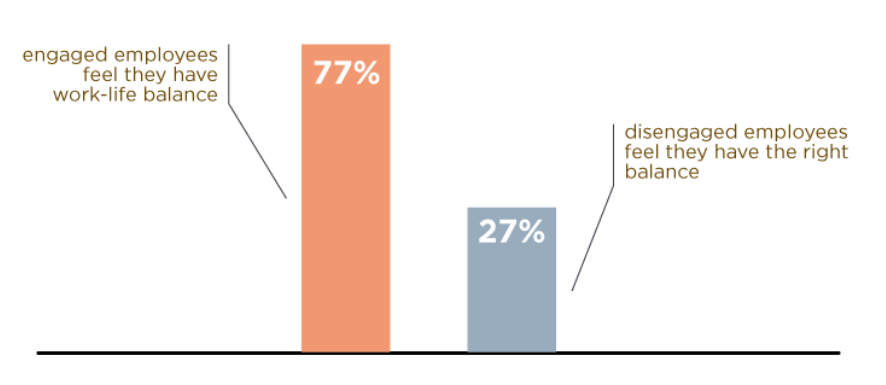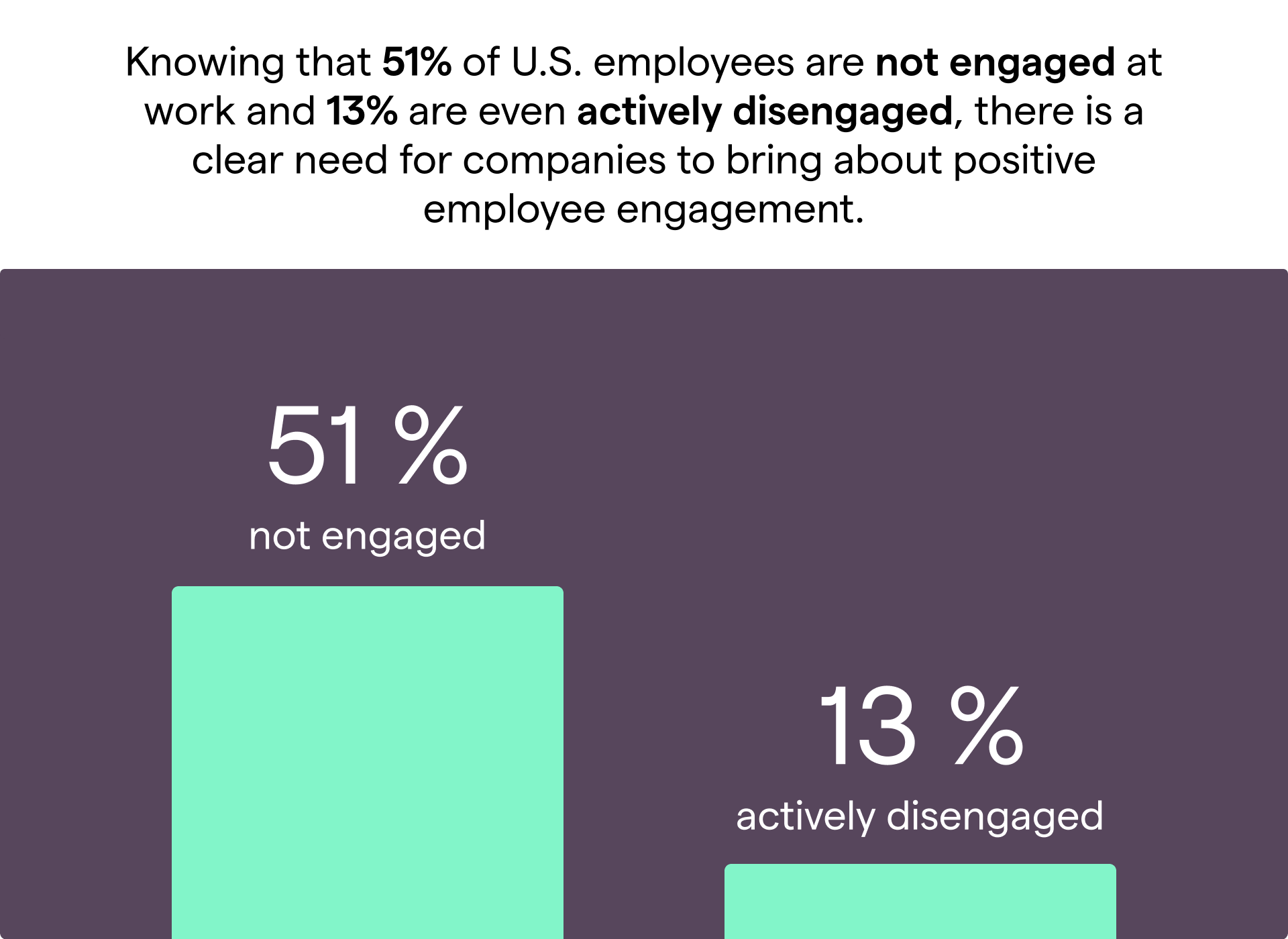Boosting employee morale and motivation in the workplace is one of the top priorities for managers, HR professionals, and internal communications professionals. The era of great resignation is highly impacting how organizations treat and manage their people. Employers are becoming more aware of the various employee experience factors impacting employee engagement and happiness at work.
An employee motivation survey of over 50,000 workers found that motivated employees are 87% less likely to leave a company. Furthermore, each year in the US, over $450 billion in losses are recorded due to having unmotivated employees.
So employers are now tasked with ensuring higher motivation levels in their workplaces.

In this blog post, we will go over the must-follow practices to boost employee morale and motivation in your company.
- 1. Provide Competitive Compensation and Benefits
- 2. Build and Nurture a Transparent Workplace Culture
- 3. Improve Internal Communications
- 4. Implement an Employee Wellbeing Program
- 5. Regularly Measure the Pulse of Your Workforce
- 6. Follow the Best DEI Practices
- 7. Train Your Managers to Become Transformational Leaders
- 8. Ensure Opportunities for Career Growth
- 9. Show Appreciation
1. Provide Competitive Compensation and Benefits
Even though some experts argue that higher pay doesn’t result in higher employee morale, this is often not the case. Of course, more factors contribute to employee morale and motivation in the workplace, but competitive and fair compensation is often the major contributing factor.
It is critical that you incentivize your employees for their hard work. This is the only way to maintain high engagement and productivity.
According to research, well-structured incentive programs can increase employee performance by as much as 44%. On the other hand, when employees feel like they are not compensated fairly, their morale drops, and they are less motivated to perform well.
How to get started
Do a detailed market analysis to understand how your company compares to other employers in the same industry. Based on the insights, make corrections to your salary rates. Alternatively, offer other attractive benefits such as meals at work or health insurance.
2. Build and Nurture a Transparent Workplace Culture
Closed company culture is one of the biggest culprits for low employee morale and motivation. According to research, 50% of employees say that lack of transparency holds their company back. Another survey by Hays showed that 47% of active job seekers want to leave their job because of bad company culture. Assessing company culture is, therefore, crucial.
These companies struggle to gain their employees’ trust, resulting in lower engagement, loyalty, commitment, and employee advocacy.
It is critical that companies openly talk about what is going on in their organization and encourage employees to do the same.
Recently, IBM conducted a study with over 1,700 CEOs from 64 countries and 18 industries. One of the major findings is that companies that outperform their peers are 30% more likely to identify openness as a key influence on their organization.
How to get started
Make transparency one of your company’s core values and communicate the benefits of transparency regularly. Then make sure that your company’s c-level executives act as role models.
For example, you can set up live quarterly Q&As with your CEO during which employees can ask questions they usually don’t have an opportunity to.
💡 Learn about other benefits of transparency in the workplace!
3. Improve Internal Communications
If you are wondering how to improve your employees’ motivation and morale, start by assessing your internal communications strategy. Today, IC professionals are considered important strategic business partners.
They play a critical role throughout every employee’s journey and are responsible for keeping employees engaged and boosting their morale. Furthermore, they can have a high impact in getting employees’ buy-in, engagements, and alignment during important company events such as digital transformation, crises, and mergers and acquisitions.
By connecting employees and ensuring organizational alignment, IC departments should strive to keep their employees in the loop and motivate them to do their best work.
📹 Check out our Masterclass to learn about how to build a successful internal communications strategy!
How to get started
Internal communications technology highly impacts how employees interact in your company. Unfortunately, too many solutions still offer basic features allowing employers just to send periodical company updates to employees.
Instead, you should look for a platform with powerful segmentation, content creation, and distribution capabilities. Only then can you create engaging and personalized content your employees will want to read and reach every employee with the right message at the right time.
Boost your employees’ morale and motivation with Haiilo communications platform!
4. Implement an Employee Wellbeing Program
With the emergence of the COVID-19 pandemic, many employers have started investing in employee well-being programs. Gallup’s research that connects employee well-being with employee engagement found that employees who work at companies that invest in their well-being are:
- 42% more likely to evaluate their overall lives highly
- 27% more likely to report “excellent” performance in their own job at work
- 45% more likely to report high levels of adaptability in the presence of change
- 59% less likely to look for a job with a different organization in the next 12 months
Because poor work-life balance is often the biggest stressor in the workplace, ensure that your program focuses on improving your employees’ work-life balance. Plenty of research has already proved that emotionally drained employees are less motivated and engaged to perform well.

How to get started?
As a part of your well-being program, you can implement a weekly or monthly internal well-being newsletter or a podcast.
Include your own content with best work-life balance practices, external content, or, better yet, employee-generated content in which your employees share their own experiences, tips, and tricks.
5. Regularly Measure the Pulse of Your Workforce
You can’t improve what you can’t measure. So the very first step toward boosting employee morale and motivation is understanding the current state of your workforce.
The best way to do so is by sending out regular pulse surveys.
A pulse survey is a short and regular set of questions sent to employees to provide useful information on employee motivation and engagement.
Such surveys are carried out to continuously gain employees’ views on their work experience and identify challenges they’re facing right now. Unfortunately, Gartner’s analysis shows that, since the start of the pandemic, only 16% of employers are using technologies more frequently to monitor their employees’ productivity, engagement, well-being, and workplace experience.
How to get started
Start with some common employee engagement surveys to understand what drives your workers’ motivation. Next, you can dig deeper with anonymous open-text surveys asking employees to describe their feelings about their work and company.
Ideally, your survey software won’t give you just raw data but valuable insights and actionable recommendations for improvement.

6. Follow the Best DEI Practices
Workplace inclusivity and diversity have a big impact on employee morale. According to Salesforce research on diversity, employees who feel their voice is heard at work are nearly five times (4.6X) more likely to feel empowered to perform their best work.
Furthermore, highly inclusive companies are more likely to hit their financial target goals by up to 120%.
So make sure that you always encourage your employees’ share of voice. Make them feel like they can share their thoughts, needs, and opinions. Once again, building a high level of trust in the workplace should be a priority for every employer as it significantly impacts employee morale.
How to get started
If your company truly cares about DEI, use this to build your employer brand and attract great talent to your organization. 67% of active and passive job seekers said that a diverse workforce is an important factor when evaluating companies and job offers.
So including your DEI initiatives and beliefs on your career site, in job descriptions, and in job ads can go a long way in recruiting great talent to your organization.
7. Train Your Managers to Become Transformational Leaders
Managers have the biggest impact on employee engagement, morale, happiness, and health. For example, Swedish researchers at the Stress Institute in Stockholm found that people with incompetent, inconsiderate, secretive, or uncommunicative managers are 60% more likely to have a heart attack.
But according to another study, 71% of managers say they know how to motivate their team, and yet only 44% of employees agree that their manager knows how to motivate them.
Closing this gap can be done with proper management hiring and training practices.
Make sure that your managers act as transformational leaders and that they know how to embed your company’s core values into their teams.
How to get started
Of course, you could implement yearly training for your managers or include a management course as a part of your onboarding process. But if you want to leverage internal knowledge, you can create a closed group of managers where they can share their experiences and give valuable advice to their fellow co-workers.
8. Ensure Opportunities for Career Growth
Ambitious employees want to be able to understand their career paths. When they see no opportunities for advancement in their organizations, their morale drops, and they are more likely to seek those opportunities elsewhere.
According to research, when employees see professional growth and career development opportunities in their organization, they are 2.5x more likely to be highly engaged than those who do not.

How to get started
Ideally, you should have clear career paths for every position in your company, explaining what it takes to get to the next level. They should be transparent and visible to your workforce, and they should be fair.
Make sure that you regularly review and perform merit-based promotions. Often, this is the best way to boost your employees’ morale and motivation and make them more loyal.
9. Show Appreciation
Do your employees feel valued for what they do? Do you encourage your managers to show acts of gratitude?
Recognition is one of the most powerful tools impacting employee engagement and performance at work. In fact, a study by Reward Gateway says that 75% of employees said their motivation and morale would improve if their managers just thanked them more often.
How to get started
Implement a formal employee recognition program. You can start with a non-monetary program that doesn’t require an extra budget. Make sure that you communicate the benefits of recognition in the workplace, and make recognition social so that everyone can participate and interact.
After a few months, do a before and after analysis. Compare your people-related KPIs before and after the implementation of the program.










